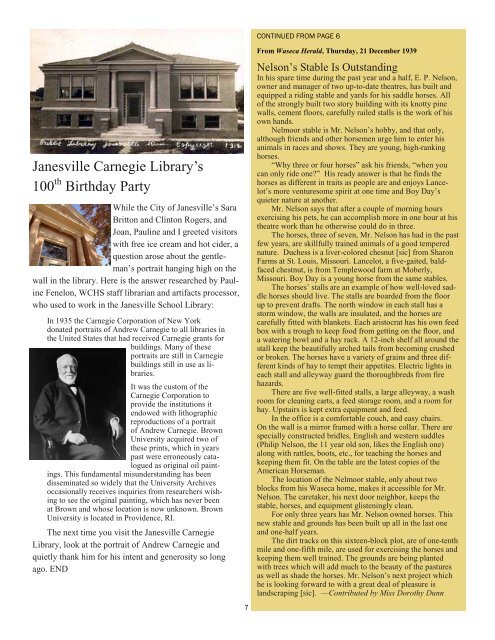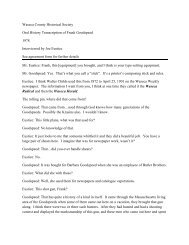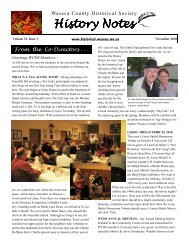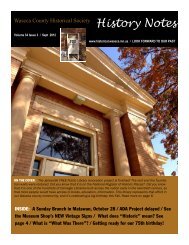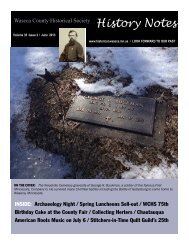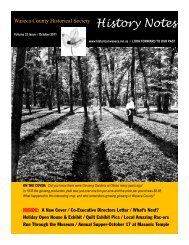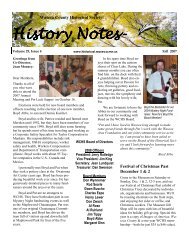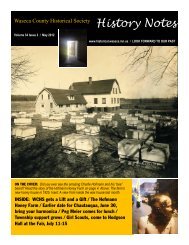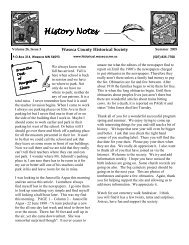December 2012 - Waseca County Historical Society
December 2012 - Waseca County Historical Society
December 2012 - Waseca County Historical Society
- No tags were found...
You also want an ePaper? Increase the reach of your titles
YUMPU automatically turns print PDFs into web optimized ePapers that Google loves.
CONTINUED FROM PAGE 6<br />
Janesville Carnegie Library’s<br />
100 th Birthday Party<br />
While the City of Janesville’s Sara<br />
Britton and Clinton Rogers, and<br />
Joan, Pauline and I greeted visitors<br />
with free ice cream and hot cider, a<br />
question arose about the gentleman’s<br />
portrait hanging high on the<br />
wall in the library. Here is the answer researched by Pauline<br />
Fenelon, WCHS staff librarian and artifacts processor,<br />
who used to work in the Janesville School Library:<br />
In 1935 the Carnegie Corporation of New York<br />
donated portraits of Andrew Carnegie to all libraries in<br />
the United States that had received Carnegie grants for<br />
buildings. Many of these<br />
portraits are still in Carnegie<br />
buildings still in use as libraries.<br />
It was the custom of the<br />
Carnegie Corporation to<br />
provide the institutions it<br />
endowed with lithographic<br />
reproductions of a portrait<br />
of Andrew Carnegie. Brown<br />
University acquired two of<br />
these prints, which in years<br />
past were erroneously catalogued<br />
as original oil paintings.<br />
This fundamental misunderstanding has been<br />
disseminated so widely that the University Archives<br />
occasionally receives inquiries from researchers wishing<br />
to see the original painting, which has never been<br />
at Brown and whose location is now unknown. Brown<br />
University is located in Providence, RI.<br />
The next time you visit the Janesville Carnegie<br />
Library, look at the portrait of Andrew Carnegie and<br />
quietly thank him for his intent and generosity so long<br />
ago. END<br />
7<br />
From <strong>Waseca</strong> Herald, Thursday, 21 <strong>December</strong> 1939<br />
Nelson’s Stable Is Outstanding<br />
In his spare time during the past year and a half, E. P. Nelson,<br />
owner and manager of two up-to-date theatres, has built and<br />
equipped a riding stable and yards for his saddle horses. All<br />
of the strongly built two story building with its knotty pine<br />
walls, cement floors, carefully railed stalls is the work of his<br />
own hands.<br />
Nelmoor stable is Mr. Nelson’s hobby, and that only,<br />
although friends and other horsemen urge him to enter his<br />
animals in races and shows. They are young, high-ranking<br />
horses.<br />
“Why three or four horses” ask his friends, “when you<br />
can only ride one” His ready answer is that he finds the<br />
horses as different in traits as people are and enjoys Lancelot’s<br />
more venturesome spirit at one time and Boy Day’s<br />
quieter nature at another.<br />
Mr. Nelson says that after a couple of morning hours<br />
exercising his pets, he can accomplish more in one hour at his<br />
theatre work than he otherwise could do in three.<br />
The horses, three of seven, Mr. Nelson has had in the past<br />
few years, are skillfully trained animals of a good tempered<br />
nature. Duchess is a liver-colored chesnut [sic] from Sharon<br />
Farms at St. Louis, Missouri. Lancelot, a five-gaited, baldfaced<br />
chestnut, is from Templewood farm at Moberly,<br />
Missouri. Boy Day is a young horse from the same stables.<br />
The horses’ stalls are an example of how well-loved saddle<br />
horses should live. The stalls are boarded from the floor<br />
up to prevent drafts. The north window in each stall has a<br />
storm window, the walls are insulated, and the horses are<br />
carefully fitted with blankets. Each aristocrat has his own feed<br />
box with a trough to keep food from getting on the floor, and<br />
a watering bowl and a hay rack. A 12-inch shelf all around the<br />
stall keep the beautifully arched tails from becoming crushed<br />
or broken. The horses have a variety of grains and three different<br />
kinds of hay to tempt their appetites. Electric lights in<br />
each stall and alleyway guard the thoroughbreds from fire<br />
hazards.<br />
There are five well-fitted stalls, a large alleyway, a wash<br />
room for cleaning carts, a feed storage room, and a room for<br />
hay. Upstairs is kept extra equipment and feed.<br />
In the office is a comfortable couch, and easy chairs.<br />
On the wall is a mirror framed with a horse collar. There are<br />
specially constructed bridles, English and western saddles<br />
(Philip Nelson, the 11 year old son, likes the English one)<br />
along with rattles, boots, etc., for teaching the horses and<br />
keeping them fit. On the table are the latest copies of the<br />
American Horseman.<br />
The location of the Nelmoor stable, only about two<br />
blocks from his <strong>Waseca</strong> home, makes it accessible for Mr.<br />
Nelson. The caretaker, his next door neighbor, keeps the<br />
stable, horses, and equipment glisteningly clean.<br />
For only three years has Mr. Nelson owned horses. This<br />
new stable and grounds has been built up all in the last one<br />
and one-half years.<br />
The dirt tracks on this sixteen-block plot, are of one-tenth<br />
mile and one-fifth mile, are used for exercising the horses and<br />
keeping them well trained. The grounds are being planted<br />
with trees which will add much to the beauty of the pastures<br />
as well as shade the horses. Mr. Nelson’s next project which<br />
he is looking forward to with a great deal of pleasure is<br />
landscraping [sic]. —Contributed by Miss Dorothy Dunn


